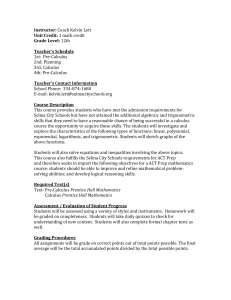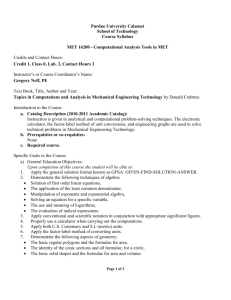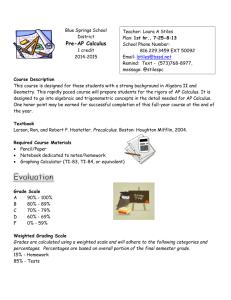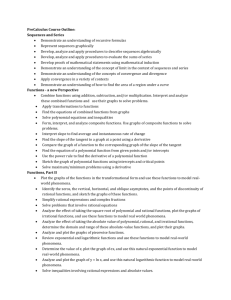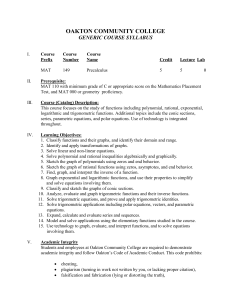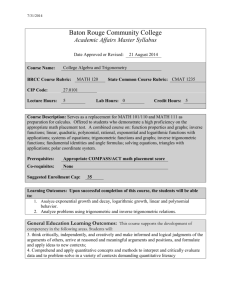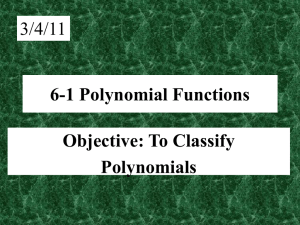Course Objectives for MATH 240, Fall 2001
advertisement
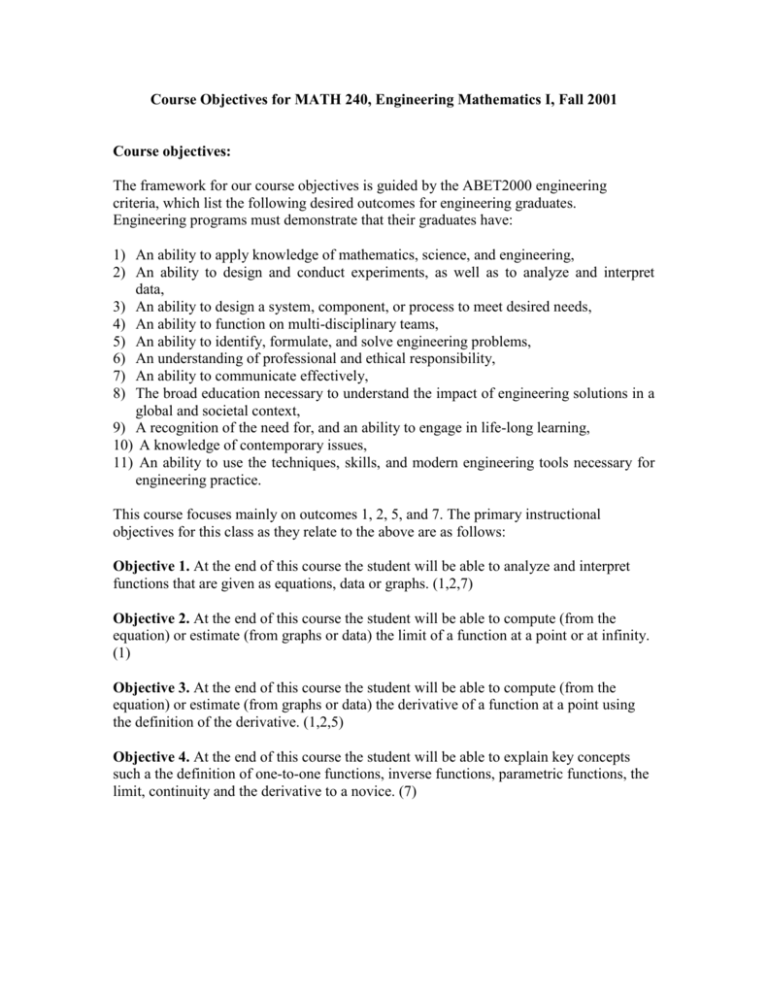
Course Objectives for MATH 240, Engineering Mathematics I, Fall 2001 Course objectives: The framework for our course objectives is guided by the ABET2000 engineering criteria, which list the following desired outcomes for engineering graduates. Engineering programs must demonstrate that their graduates have: 1) An ability to apply knowledge of mathematics, science, and engineering, 2) An ability to design and conduct experiments, as well as to analyze and interpret data, 3) An ability to design a system, component, or process to meet desired needs, 4) An ability to function on multi-disciplinary teams, 5) An ability to identify, formulate, and solve engineering problems, 6) An understanding of professional and ethical responsibility, 7) An ability to communicate effectively, 8) The broad education necessary to understand the impact of engineering solutions in a global and societal context, 9) A recognition of the need for, and an ability to engage in life-long learning, 10) A knowledge of contemporary issues, 11) An ability to use the techniques, skills, and modern engineering tools necessary for engineering practice. This course focuses mainly on outcomes 1, 2, 5, and 7. The primary instructional objectives for this class as they relate to the above are as follows: Objective 1. At the end of this course the student will be able to analyze and interpret functions that are given as equations, data or graphs. (1,2,7) Objective 2. At the end of this course the student will be able to compute (from the equation) or estimate (from graphs or data) the limit of a function at a point or at infinity. (1) Objective 3. At the end of this course the student will be able to compute (from the equation) or estimate (from graphs or data) the derivative of a function at a point using the definition of the derivative. (1,2,5) Objective 4. At the end of this course the student will be able to explain key concepts such a the definition of one-to-one functions, inverse functions, parametric functions, the limit, continuity and the derivative to a novice. (7) Specific objectives and how they relate to the primary objectives are as follows. The objectives are broken up to give exam-by-exam objectives. We should be able to maintain a pace that allows us to adhere to this schedule. The instructor reserves the right to adjust/modify/add to this schedule. At the end of MATH 240 the student will be able to Exam 1: 1. Evaluate functions (including compositions of functions) (using equations, graphs, data, verbal descriptions) and interpret answers. (1,4) 2. Determine domains and ranges of functions (using equations, graphs, data, verbal descriptions). (1) 3. Determine if a graph or data represents a function. (1) 4. Find intercepts of a function (from the equation or graph). (1) 5. Graph a function from either the equation or data, indicating important points. (1) 6. Graph quadratic and polynomial functions. (1) 7. Graph functions using shifting, stretching, reflecting and scaling. (1) 8. Graph trigonometric functions.(1) 9. Evaluate trigonometric functions using trigonometric identities. (1) Exam 2: 10. Sketch a parametric curve from the equations. (1,4) 11. Given a Cartesian equation, represent it as a pair of parametric equations and vice versa (when possible). (1) 12. Evaluate and graph exponential functions. (1) 13. For if-then statements, determine whether they are true (justify) or false (give a counterexample), (4) 14. Determine the converse and contrapositive of an if-then statement (4) 15. Rewrite biconditional statements as two separate if-then statements and vice versa. (4) 16. Determine if a function is one-to-one (using either the equation, data, or graph). (1,4) 17. Compute the inverse of a function (using equations, data or graphs). (1) 18. Restrict the domain of a function to make it one-to-one. (1) 19. Graph logarithmic functions. (1) 20. Graph inverse trigonometric functions. (1) 21. Evaluate / simplify logarithmic expressions. (1) 22. Expand and condense logarithmic expressions. (1) 23. Solve logarithmic and exponential equations. (1) 24. Model growth phenomena using exponential functions. (1) 25. Compress scales using logarithms. (1) 26. Simplify algebraic expressions involving rational functions, complex fractions, and radicals. (1,2,3) 27. Find / approximate the slope and equation of a secant line or tangent line to a function at specified points/point. (1,3) 28. Find average and instantaneous velocity. (1,3) 29. Evaluate limits of functions using graphs, tables of function values, limit laws and theorems. (1,2) Exam 3: 28. Find average and instantaneous velocity. (1,3) 29. Evaluate limits of functions using graphs, tables of function values, limit laws and theorems. (1,2) 30. Identify polynomials / master the accompanying terminology. (1) 31. Find discontinuities of a function, describe the type of discontinuity and tell which part(s) of the continuity definition fail, using either an equation or a graph. (1,4) 32. Find approximate zeros of a polynomial. (1) 33. Solve polynomial inequalities. (1) 34. Find vertical and horizontal asymptotes, evaluate infinite limits and limits at infinity, using either graphs or equations. (1,2) 35. Apply the Intermediate Value Theorem. (1, 4) 36. Sketch the graph of a function with specified properties. (1,4) 37. Evaluate / simplify expressions involving negative and fractional exponents. (1) 38. Calculate the derivative of a function using the limit definition. (1,3) Remaining topics for Exam 4 + final (augmented by earlier topics): 38. Calculate the derivative of a function using the limit definition. (1,3) 39. Determine the meaning of specific derivatives. (4) 40. Estimate derivatives of functions represented by data. (1,3) 41. Sketch the graphs of functions from the graphs of their derivatives and vice versa. (1,4) 42. Identify x-values at which a function is not differentiable and state why. (1,4) 43. Find the linear approximation of a function and use it to approximate nearby function values. (1,3) 44. Determine properties of a function (increasing, decreasing, concavity, extrema, points of inflection) from the graph(s) of its derivatives. (1,4) Assessment. Achievement of the above objectives will be demonstrated by satisfactory performance on homeworks, journal entries and examinations.


